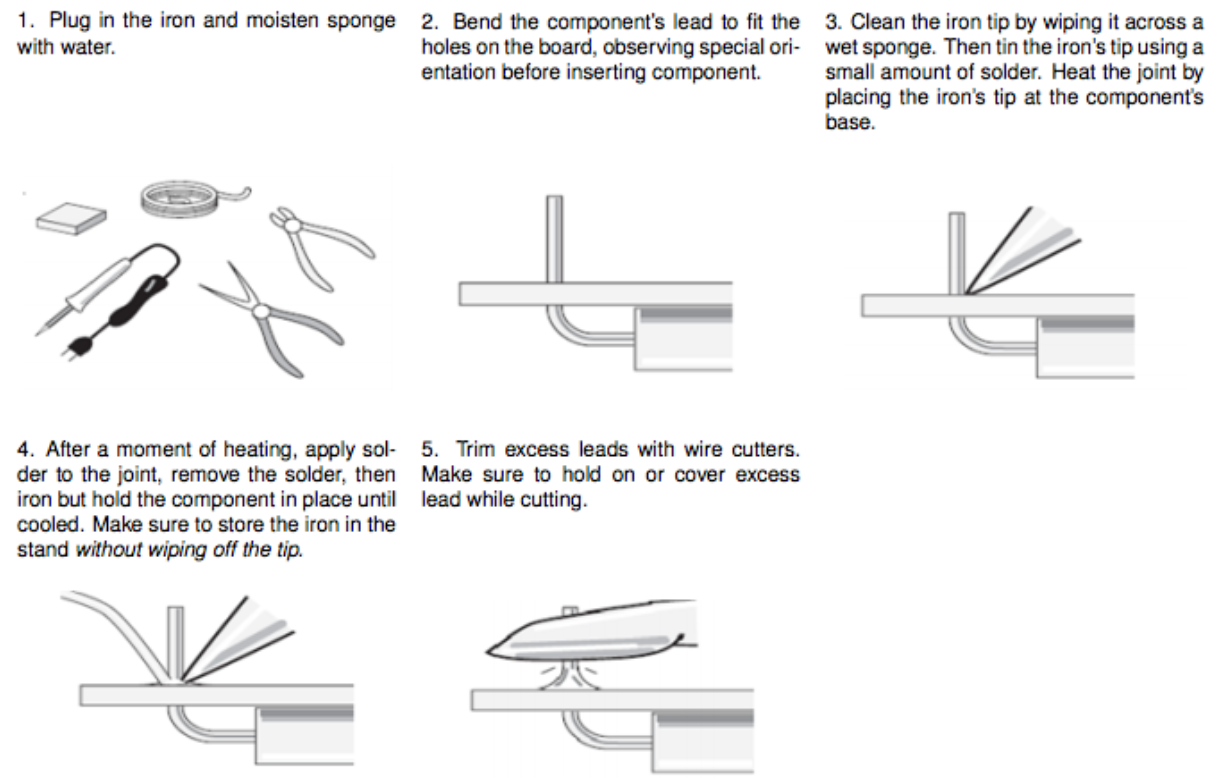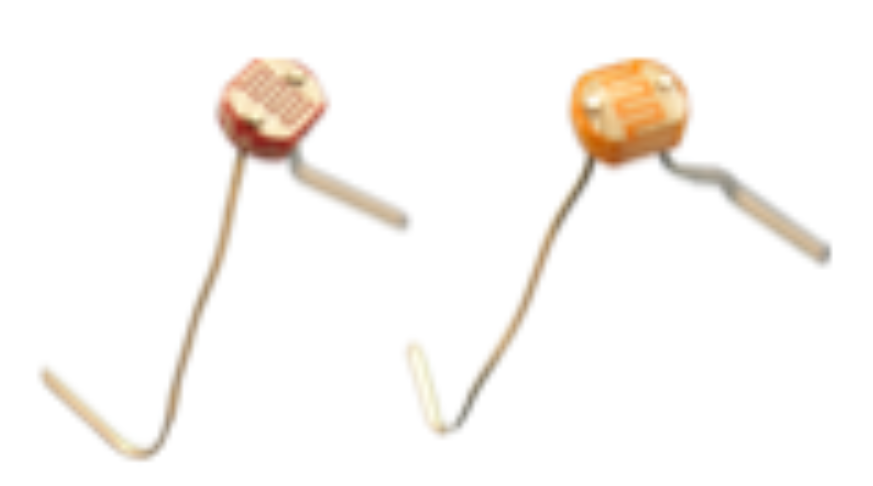You are viewing an older revision! See the latest version
Lab 1
Chapter 1: Welcome to ECE 111¶
Section Overview¶
Welcome to the ECE 111 lab manual! For many students, this may be their first exposure to soldering (pronounced saw-der-ing) and assembling an electrical system. Therefore, this manual has been written with the assumption that the assembler has very little knowledge of these skills.
Objectives¶
- Lab etiquette
- Resources
- Soldering
- Using the resistor value tables
Materials¶
- KL-46z
- USB to mini cable
- Tool Kit
- Soldering iron tip and barrel nut
- Solder
Lab Etiquette¶
Proper etiquette in the labs is important when working with other students and Teaching Assistants (TAs). Engineers work with many different types of people and need to be able to do so proficiently. Another part of proper lab etiquette is cleanliness in the lab. Engineers work in a variety of spaces; some can work in spaces that are exclusively theirs but many work in shared spaces. When sharing work spaces, respect others that must use that space by keeping it clean and removing messes when finished.
Students¶
To get the fullest experience out of lab, students are expected to:
- Prepare for each lab. Students should read each section in the lab manual before going to lab. This ensures all the required tools are prepared and any questions for the TAs are ready.
- Ask questions. Students should talk to their peers and the TAs when questions arise. Other people will have different perspectives on an issue.
- Respect their peers. Everybody comes from a different background and has a different level of knowledge but everybody deserves the same level of respect.
Teaching Assistants (TAs)¶
Teaching Assistants are expected to:
- Ensure the lab is prepared. TAs make sure the room the lab is located in and the provided materials are prepped for the students during their assigned lab sections.
- Fairly assess student performance. TAs should outline their requirements for full credit on prelabs and study questions at the beginning of the term and grade to this standard for the term.
- Help students think through problems in lab. TAs will not give instant answers to problems encountered. They are available to guide students towards the correct answer.
Workspace¶
A messy workspace can be a safety hazard and create a chaotic environment. It is much easier to lose a small component when there are other items cluttering the table top. It is also important to keep a workspace clean because there are other classes that use the same room for their labs. Respect the lab and the other people that are working in the lab.
Resources¶
There are many sources of information available for students in need of help. There is a hierarchy that students should follow to ask questions before going straight to the instructor. Resources located higher in the hierarchy will be high quality but also more scarce. When a student has a question they should start on the first level to ask questions and progress from there.
- Yourself Students who encounter problems should first examine the issue and attempt to solve the problem on their own.
- Peers A student’s peers should be the second resource utilized when a question arises. Asking peers helps the student with the question and it reinforces the concept to the person asked when they explain it. A student has many peers so the total amount of time available with peers is much more than any other resource.
- Teaching Assistants Teaching Assistants (TAs) have gone through this material before and are confident with the content, making them a valuable source of information. They have recent experience as a student in the course and can offer insight regarding the course.
- Instructor Going to the instructor or professor with a question should happen when other students and the TAs couldn’t help. There is only a limited amount of time that an instructor is available for students to ask questions. However, instructors will know the most about a topic and how it pertains to the course.
Academic Dishonesty¶
The following is taken from the Oregon University System, Oregon State University Student Conduct Code.
- Academic or Scholarly Dishonesty is defined as an act of deception in which a Student seeks to claim credit for the work or effort of another person, or uses unauthorized materials or fabricated information in any academic work or research, either through the Student’s own efforts or the efforts of another.
- It includes:
- CHEATING – use or attempted use of unauthorized materials, information or study aids, or an act of deceit by which a Student attempts to misrepresent mastery of academic effort or information. This includes but is not limited to unauthorized copying or collaboration on a test or assignment, using prohibited materials and texts, any misuse of an electronic device, or using any deceptive means to gain academic credit.
- FABRICATION – falsification or invention of any information including but not limited to falsifying research, inventing or exaggerating data, or listing incorrect or fictitious references.
- ASSISTING – helping another commit an act of academic dishonesty. This includes but is not limited to paying or bribing someone to acquire a test or assignment, changing someone’s grades or academic records, taking a test/doing an assignment for someone else by any means, including misuse of an electronic device. It is a violation of Oregon state law to create and offer to sell part or all of an educational assignment to another person (ORS 165.114)
- TAMPERING – altering or interfering with evaluation instruments or documents.
- PLAGERISM – representing the words or ideas of another person or presenting someone else’s words, ideas, artistry or data as one’s own, or using one’s own previously submitted work. Plagerism includes but is not limited to copying another person’s work (including unpublished material) without appropriate referencing, presenting someone else’s opinions and theories as one’s own, or working jointly on a project and then submitting it as one’s own work.
- Academic Dishonesty cases are handled initially by the academic units, following the process outlined in the University’s Academic Dishonesty Report Form, and will also be referred to SCCS for action under these rules. http://arcweb.sos.state.or.us/pages/rules/oars 500/oar 576/576 015.html
Preparation¶
Proper preparation allows for a smoother and more efficient lab time. Follow these steps before starting each lab.
- Start with a clean work space. Electronic components are very small and if dropped, could be easily lost in desk clutter. Therefore, put away papers, keyboards, mice, clothing, etc.
- Keep electronic parts neatly organized. Often times, parts come neatly packaged and ready for use. Do not dump all of these parts together, such as in a box. Instead, if parts come separated, try to keep them that way. To stay organized, rather than spreading components out across the desk, use a small container. Some people use ice cube trays, kitchen bowls, art supply boxes, or other containers for convenient organization of parts.
- Care for tools. The quality of electronics assembly is based on personal experience and tools used for assembly. Hence, try to keep tools in the best condition possible. When using cutting tools, try not to cut things that the tools are not designed to cut.
- Gather all supplies. When working on a project, there is nothing more annoying than not having the parts needed, and having to stop working to go find them. Prevent this frustration by double-checking all supplies before starting. This includes manuals, tools, components, pens, and paper.
How to Solder¶
Never touch a component or the tip of the soldering iron while soldering! Return soldering iron to its stand when not in use. In step 5, cover the lead that is being cut to prevent it from flying away. A variety of different soldering tutorials are available online to help with this process. More soldering hints can be found on the TekBots webpage.

Preparing the KL-46z¶
Some soldering is necessary to prepare the KL-46z for this lab. Male header needs to be soldered into the small holes along the two long sides of the KL-46z board. Aquire one 12 pin, two 16 pin long strips of male header and one 20 pin long strip; two are needed for each long sides of the board.
- Prepare to solder with the instructions from the previous section.
- Solder each pin to the board using the instructions from the previous section.
- Repeat for the other sides of the board.
When soldering the first piece of male header to the KL-46z, it may be beneficial to find something small to put under the other edge of the board to keep the header and the PCB perpendicular.
Resistor Values¶
A resistor is a component that limits electrical current. Current creates a voltage drop across the two terminals of the
resistor. Most resistors use a pattern of colored strips to indicate the resistance value. The diagram below shows
how to read the resistor values.
From the above figure, the color is Red, Black, Green, and Gold Red = 2, Black = 0, Green = 5 (zeros), Gold = ± 5% The
resistor value is in between 2, 000, 000 × (1 − 0.05) = 1.9MΩ and 2, 000, 000 × (1 + 0.05) = 2.1MΩ
Making Measurements¶
Use the resistor in the ECE 111 kit. This exercise uses the Digital Multimeter (DMM) to measure resistance. For instructions on how to use a DMM, reference lab 2 under section 2.5.
- Fill-in the band colors:
- Fill-in values of the colors:
- Calculated Resistance:
- Measure Resistance using DMM: Are the values within the specified tolerance?
TA Signature: ___________
(Lab Work Readable/Board is Prepared)
Study Questions¶
Type answers to the study questions below. Please keep answers clear and concise. Turn in the questions at the beginning of lab next week. You will be required to type all study questions for the future labs as well.
- Soldering can be used for making one-of-a-kind things (prototyping) but there are many other ways of prototyping too. Find two other ’ways’ of prototyping electronics circuits.
- Use this link to see details about the KL46Z microcontroller chip. How much does the chip used on your lab kit cost?
- Use this link to see details about the KL46Z development board. How much does this board cost?
Challenge¶
Measure the resistance of the resistor shown in Figure ?? Note: These resistors can be obtained from your TA.

Is there anything special about this type of resistor? Type a description and turn it in with the study questions.